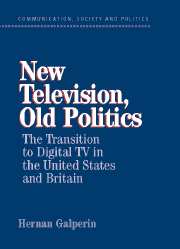Preface and Acknowledgments
Published online by Cambridge University Press: 24 July 2009
Summary
When this project began in the fall of 1998, some colleagues warned me that it might have short legs. By the time of completion, the problems and debates about how best to undertake the transition from analog to digital television might be a thing of the past. Only a handful of academics and media historians would find interest in the intricacies of past battles about digital broadcasting standards, spectrum property rights, switchover strategies, and so forth. To my fortune, today, five years and a book later, these issues remain more relevant than ever. Moreover, the findings of this investigation reveal much about the future of communications in postindustrial societies. Television sits at the intersection of old and new media, and, for all the attention gathered by new information and communication technologies, it is still a dominant political and cultural force in modern life. As new technologies challenge the existing media industry arrangements, questions that have not been asked since the formative years of television in the early twentieth century resurface. The transition thus offers a unique opportunity to study how old politics and new technologies are shaping modern communications networks, for it is precisely in disruptive times that the political-economic foundations of our institutions can be best examined.
My first and foremost gratitude is due to the dozens of civil servants, policymakers, academics, industry analysts, and company executives interviewed for this project between 1998 and 2002. Without their generous cooperation and support, this book would not have been possible.
- Type
- Chapter
- Information
- New Television, Old PoliticsThe Transition to Digital TV in the United States and Britain, pp. xi - xiiPublisher: Cambridge University PressPrint publication year: 2004

